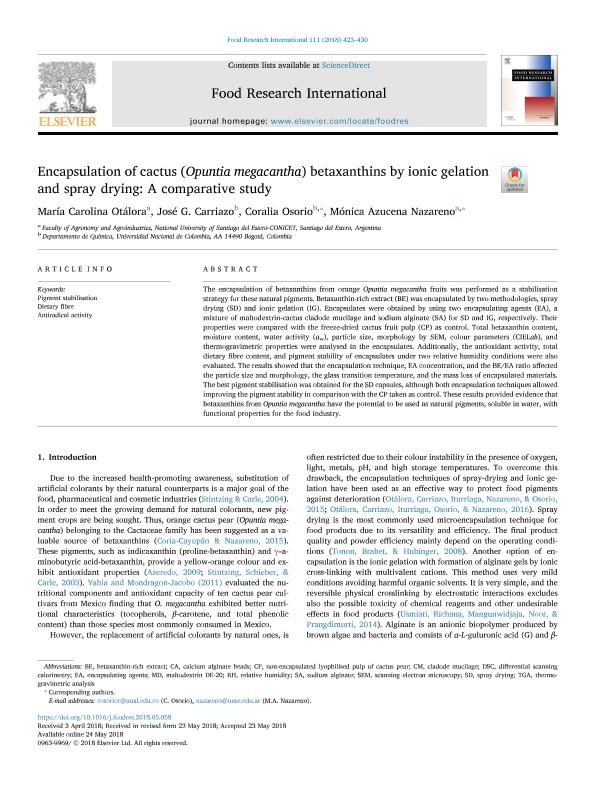Mostrar el registro sencillo del ítem
dc.contributor.author
Otalora Rodriguez, Maria Carolina

dc.contributor.author
Carriazo, José G.
dc.contributor.author
Osorio, Coralia
dc.contributor.author
Nazareno, Mónica Azucena

dc.date.available
2019-12-27T20:24:25Z
dc.date.issued
2018-09
dc.identifier.citation
Otalora Rodriguez, Maria Carolina; Carriazo, José G.; Osorio, Coralia; Nazareno, Mónica Azucena; Encapsulation of cactus ( Opuntia megacantha ) betaxanthins by ionic gelation and spray drying: A comparative study; Elsevier Science; Food Research International; 111; 9-2018; 423-430
dc.identifier.issn
0963-9969
dc.identifier.uri
http://hdl.handle.net/11336/93165
dc.description.abstract
The encapsulation of betaxanthins from orange Opuntia megacantha fruits was performed as a stabilisation strategy for these natural pigments. Betaxanthin-rich extract (BE) was encapsulated by two methodologies, spray drying (SD) and ionic gelation (IG). Encapsulates were obtained by using two encapsulating agents (EA), a mixture of maltodextrin-cactus cladode mucilage and sodium alginate (SA) for SD and IG, respectively. Their properties were compared with the freeze-dried cactus fruit pulp (CP) as control. Total betaxanthin content, moisture content, water activity (aw), particle size, morphology by SEM, colour parameters (CIELab), and thermogravimetric properties were analysed in the encapsulates. Additionally, the antioxidant activity, total dietary fibre content, and pigment stability of encapsulates under two relative humidity conditions were also evaluated. The results showed that the encapsulation technique, EA concentration, and the BE/EA ratio affected the particle size and morphology, the glass transition temperature, and the mass loss of encapsulated materials. The best pigment stabilisation was obtained for the SD capsules, although both encapsulation techniques allowed improving the pigment stability in comparison with the CP taken as control. These results provided evidence that betaxanthins from Opuntia megacantha have the potential to be used as natural pigments, soluble in water, with functional properties for the food industry.
dc.format
application/pdf
dc.language.iso
eng
dc.publisher
Elsevier Science

dc.rights
info:eu-repo/semantics/openAccess
dc.rights.uri
https://creativecommons.org/licenses/by-nc-sa/2.5/ar/
dc.subject
PIGMENT STABILIZATION
dc.subject
DIETARY FIBER
dc.subject
ANTIRADICAL ACTIVITY
dc.subject
FOOD COLORANT
dc.subject.classification
Química Orgánica

dc.subject.classification
Ciencias Químicas

dc.subject.classification
CIENCIAS NATURALES Y EXACTAS

dc.title
Encapsulation of cactus ( Opuntia megacantha ) betaxanthins by ionic gelation and spray drying: A comparative study
dc.type
info:eu-repo/semantics/article
dc.type
info:ar-repo/semantics/artículo
dc.type
info:eu-repo/semantics/publishedVersion
dc.date.updated
2019-12-20T22:55:46Z
dc.journal.volume
111
dc.journal.pagination
423-430
dc.journal.pais
Países Bajos

dc.description.fil
Fil: Otalora Rodriguez, Maria Carolina. Universidad Nacional de Santiago del Estero. Facultad de Agronomía y Agroindustrias; Argentina. Consejo Nacional de Investigaciones Científicas y Técnicas; Argentina
dc.description.fil
Fil: Carriazo, José G.. Universidad Nacional de Colombia; Colombia
dc.description.fil
Fil: Osorio, Coralia. Universidad Nacional de Colombia; Colombia
dc.description.fil
Fil: Nazareno, Mónica Azucena. Consejo Nacional de Investigaciones Científicas y Técnicas; Argentina. Universidad Nacional de Santiago del Estero. Facultad de Agronomía y Agroindustrias; Argentina
dc.journal.title
Food Research International

dc.relation.alternativeid
info:eu-repo/semantics/altIdentifier/url/https://www.sciencedirect.com/science/article/pii/S0963996918304265
dc.relation.alternativeid
info:eu-repo/semantics/altIdentifier/doi/http://dx.doi.org/10.1016/j.foodres.2018.05.058
Archivos asociados
